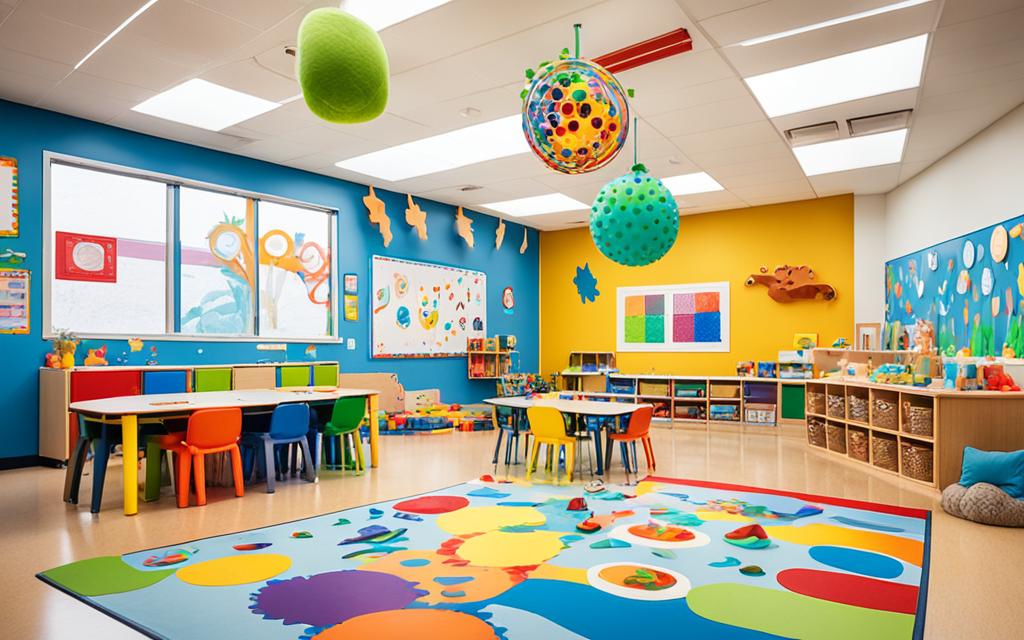Sensory Integration in Pre-School Education Methods
Embarking on educational journeys, pre-school educators in the United Kingdom recognise the transformative impact of sensory integration within pre-school education methods. As a cornerstone of early childhood development, these methods are instrumental in shaping a child’s foundational understanding of their environment. Sensory integration nurtures the whole child, catering not only to intellectual growth but also to emotional and physical development, fostering a holistic understanding of the world through the lens of their burgeoning senses.
As you venture into this influential domain of pedagogy, you gain insight into the essence of childhood learning. Sensory integration in early education is not merely about stimulating the five senses; it is about creating a web of experiences that helps young minds to connect and make sense of the complex world around them. Through thoughtfully designed sensory activities and environments, you can influence children’s cognitive skills, social interactions, and beyond. Discover why incorporating sensory integration into pre-school settings not only enriches the learning experience but is vital for the dynamic growth of early learners.
Key Takeaways
- Sensory integration is essential for comprehensive early childhood development.
- Engaging pre-schoolers in sensory experiences enhances their learning and cognition.
- This approach prepares children for the wider world by honing their sensory processing abilities.
- Pre-school education methods that include sensory integration support emotional and physical growth.
- Creating a sensory-rich environment is a key factor in fostering an effective pre-school learning setting.
Understanding Sensory Integration in Early Childhood Education
At the core of early childhood education lies the concept of sensory integration – an approach that is rapidly shaping the way we consider developmentally appropriate pedagogy for pre-schoolers. Sensory experiences, carefully woven into the fabric of daily learning, contribute significantly to the holistic development of young minds, allowing them to make sense of the world around them. As we unpack this crucial element, it becomes evident why a strong sensory foundation is instrumental in shaping the cognitive and neurological growth of children.
What Is Sensory Integration?
Sensory integration is the process by which the brain organises and interprets sensory input. This includes touch, taste, smell, sight, hearing, as well as proprioceptive (sense of position and movement) and vestibular (sense of balance) information. For pre-schoolers, this involves a dynamic interplay between sensory experiences and their ensuing behavioural responses. Mastery of sensory integration can aid children in accomplishing complex learning tasks and navigating social interactions.
Why It’s Crucial for Early Development
During these formative years, sensory processing is a vital underpinning for early childhood development. It contributes to vital developmental milestones, including motor skills, language acquisition, and emotional self-regulation. When educators and care providers optimise sensory experiences, they harness a tool that can accelerate learning and provide a springboard for future academic success.
The Science Behind Sensory Processing
Sensory processing is deeply rooted in neurological science. The brain’s plasticity, especially in the early years, allows for an incredible amount of growth and adaptation in response to sensory stimuli. The development of the neural pathways responsible for sensory integration can significantly influence cognitive functions. This neural cross-communication underpins essential skills such as concentration, problem-solving, and social interaction – competencies that are fundamental for any child working with pre-schoolers.
- Sensory experiences sharpen perceptual skills
- Sensory processing is linked to neural development
- Early childhood development benefits extensively from sensory-based learning strategies
| Sensory Modality | Role in Early Education |
|---|---|
| Visual | Enhances pattern recognition and visual tracking vital for reading and writing. |
| Auditory | Supports language development and the ability to differentiate sounds in speech. |
| Tactile | Aids fine motor skills and haptic perception – key for handwriting and artistic expression. |
| Olfactory & Gustatory | Encourages exploration and discussion of sensory attributes, enriching vocabulary. |
| Proprioceptive | Helps children understand body awareness and control, crucial for physical activity. |
| Vestibular | Crucial for developing balance and spatial orientation, impacting movement and coordination. |
As you integrate these elements into your practice, remember that each child has unique sensory needs. Sensitivity and adaptation are the hallmarks of successfully working with pre-schoolers to facilitate robust early childhood development.
Identifying Children’s Sensory Needs in a Pre-School Setting
When navigating the bustling environment of a pre-school, it is essential for educators and parents to be attuned to children’s sensory needs. These needs can vary widely among individuals and, if met with the right sensory activities and play, have the potential to significantly aid a child’s development. Recognising the signs of sensory seeking or avoidance behaviours is your first step in tailoring a supportive learning atmosphere.
Children who may require additional sensory input will often seek out experiences that stimulate their senses. They might be the first to dive into tactile play, or they could be particularly drawn to bright, colourful objects. Conversely, those who are sensory sensitive might shy away from activities with robust sensory aspects, such as loud noises or strong smells. Accurate identification of these tendencies ensures that every child receives the right balance of sensory interaction.
- Observe how a child interacts in group settings—do they prefer certain textures or types of play?
- Notice any patterns—does the child often cover their ears during noisy times or squint in bright light?
- Maintain open communication with parents—share observations and inquire about any sensory preferences at home.
Adopting various sensory play methodologies within the pre-school setting can be hugely beneficial. It allows children to explore and learn at their own pace, in a way that feels comfortable and enjoyable for them.
| Sensory Need | Signs to Look For | Possible Activities |
|---|---|---|
| Tactile | Frequent touching of materials, clothing, or other textures. | Texture exploration stations with sand, rice, or water play. |
| Auditory | Responses to certain sounds, or seeking out musical or rhythmic stimuli. | Music-making sessions, using instruments or everyday objects. |
| Visual | Attraction to bright colours or patterns, or need for quieter visual environments. | Light play with coloured transparencies, sorting games with coloured objects. |
| Olfactory & Taste | Reactions to smells or tastes, either avoidance or seeking out. | Smell identification games, or taste tests with various edible items. |
| Proprioceptive | Desire for pressure or resistance, like tight hugs or burrowing under cushions. | Obstacle courses, jumping activities, or tug-of-war games. |
| Vestibular | Seeking movement, spinning, or rocking, or alternatively, avoiding such movements. | Swinging, spinning in circles, balance beam activities. |
Remember, the key to a successful sensory-rich pre-school environment is in maintaining diversity in activities and an openness to adapt based on each child’s response. Be vigilant, flexible, and mindful as you craft an inclusive sensory world within your classroom that meets the needs of all pupils.
Sensory Integration as a Method of Work with Pre-School and
Providing a solid foundation in the early years is essential for the wholesome development of children, and sensory integration plays a pivotal role in this stage. As an educator or caregiver working with pre-schoolers, you understand the significance of including sensory activities in the curriculum. This section will guide you through the methodology and how you can seamlessly integrate sensory practices in your educational approach.
Children are naturally curious, and their learning is most profound when they can touch, see, smell, taste, and hear their environment. Therefore, incorporating sensory integration allows children to process information through their senses, which is vital for brain development and building neural pathways.
Here is a glimpse at how you can incorporate sensory activities into your day-to-day interaction with pre-schoolers:
- Start with simple sensory boxes filled with different textures for children to explore.
- Plan tactile walks where children can walk on different surfaces barefoot and describe how it feels.
- Orchestrate a sound identification game to fine-tune their auditory processing.
When integrating these practices, it’s crucial to observe children’s reactions and adapt activities to suit their individual needs. Hygiene and safety should not be overlooked, so always monitor sensory play closely to maintain a secure environment.
Consider the following table that outlines examples of sensory integration methods and their potential impact on the development of pre-schoolers:
| Method | Description |
|---|---|
| Finger Painting | Improves fine motor skills and allows for creative expression. |
| Playdough Construction | Enhances hand-eye coordination and encourages imaginative play. |
| Sound Matching | Refines auditory discrimination and memory recall abilities. |
| Aromatherapy Play | Uses calming scents to increase concentration and reduce anxious behaviours. |
| Balance Beam Activities | Promotes proprioceptive input and improves balance and coordination. |
Through this sensory-centred educational approach, you will facilitate a welcoming and stimulating environment that caters to the diverse learning needs of young children. Embrace sensory integration and witness the transformative effect it has on your work with pre-schoolers.
Strategies for Incorporating Sensory Play in Daily Activities
As a pre-school educator, your objective is to weave sensory play into the fabric of daily activities, creating a tapestry of tactile, auditory, and visual experiences that promote cognitive development. Sensory play is not an isolated event; it should be a fundamental aspect of daily routines, ensuring children benefit from enhanced sensory experiences continuously. To support this integration, consider the following strategies that can easily be adopted into your pre-school education setting.
Tactile Texture Walk: Assemble a path with various textured materials—think bubble wrap, felt, and artificial grass—for a sensory walk. This activity can be included in daily transitions, such as moving from indoors to outdoors.
Sensory Sound Bags: Create bags filled with items that make different sounds. Fabric, beads, and dried beans can offer a range of auditory stimulations. These bags can be used during story time or as a calm-down activity after play.
Visual Discovery Bottles: Fill clear bottles with colourful items that move or float, such as glitter or oil in water. These can be fantastic for circle time, capturing the children’s attention and sparking curiosity.
Remember, it’s imperative for you to observe the children’s reactions to these sensory experiences—this will help you tailor future activities to best suit their preferences and developmental stages.
- Implement a ‘Sensory Station’ in a corner of the classroom, where different textures, scents, and sounds can be explored in a quiet, focused setting.
- Mealtime Moments can be opportunities for sensory learning—encourage the children to discuss the textures and flavours they experience.
- During Outdoor Exploration, prompt discovery by asking children to find objects that have specific textures, colours, or smells.
By embedding sensory play into the schedule, you enrich the youngsters’ pre-school education with varied stimulations that are key to their developmental progress. Integrating sensory play into daily activities ensures a holistic approach to learning that supports their burgeoning curiosity and desire to explore the world through their senses.
Maximising Sensory Experiences for Pre-Schoolers
Creating an environment that caters to and enhances the sensory experiences of pre-schoolers is fundamental to their cognitive and physical development. By incorporating sensory activities into the classroom, educators can stimulate sensory processing and construct a multi-sensory setting that is both engaging and educational.
Multi-Sensory Environments in the Classroom
Designing a classroom that engages multiple senses simultaneously can significantly benefit a child’s sensory processing abilities. Different textures, visual aids, sounds and scents can all be harmoniously integrated to create a rich learning atmosphere. Here are some examples of multi-sensory environments in the classroom:
- Textured wall panels and rugs for tactile exploration
- Colourful visuals paired with corresponding audio cues
- Interactive whiteboards for combined visual and touch input

Outdoor Sensory Integration Opportunities
Outdoor environments unfold endless opportunities for multi-sensory learning. Nature itself is a vast playground where children can see, touch, smell, hear, and even taste the elements around them. Educators can facilitate outdoor sensory experiences through:
- Garden areas where children can engage with various plant textures and scents
- Sound exploration stations with natural and man-made objects
- Water play areas to explore fluid dynamics and temperature differences
Using Everyday Objects for Sensory Experiences
It’s not always necessary to have specialised equipment to foster sensory experiences. Everyday objects can be excellent tools for stimulating senses and enhancing learning. Incorporate items from the surroundings and create an enriching experience with:
- Kitchen utensils for exploring sounds and coordination
- Fabric scraps of different textures for tactile sense
- Fruits and vegetables for olfactory and gustatory sensation activities
Consider how you might transform everyday lessons into opportunities for sensory enrichment. For example:
| Activity | Sensory Input | Learning Outcome |
|---|---|---|
| Letter formation in sand trays | Tactile and visual | Improvement of hand-eye coordination and letter recognition |
| Counting with scented beads | Olfactory, tactile and visual | Development of counting skills and sensory discrimination |
| Listening to stories with sound effects | Auditory and visual | Enhanced comprehension and memory retention |
Remember, the ultimate goal is to create an inclusive learning environment that offers a variety of sensory experiences, addressing the needs of all children and ensuring they can participate fully in sensory play and exploration.
Adapting Sensory Activities for Different Needs and Abilities
As an educator, enriching the pre-school experience through sensory activities is paramount, especially considering the varied needs and abilities within any group. It is essential to ensure that these activities are inclusive and engaging for all children, inclusive of those with sensory processing disorders. This involves careful crafting and customisation of sensory activities that cater to the individual levels of sensory input each child requires.
Personalising Sensory Bins and Stations
Personalisation is key when it comes to designing sensory bins and stations. Variety can stimulate engagement, and by providing options, children will naturally gravitate towards what feels comfortable for them. Including a range of textures, scents, and colours can cater to different preferences and introduce children to new sensory experiences in a safe and controlled manner.
Modifying Activities for Children with Sensory Processing Disorders
Children with sensory processing disorders may experience sensory activities differently. Modifications, such as diminishing noise levels or reducing the bright colours, can make a significant difference. It’s not about avoiding certain activities, but adapting them to ensure they are non-threatening and enjoyable for children who may be overly sensitive to specific sensory input.
Assessing Individual Responses to Sensory Input
Continuous assessment is vital in calibrating activities according to the responses of each child. Observing, noting reactions, and asking for feedback can build a clearer picture of how each child interacts with sensory input. This insight allows for adjustments that can help in tailoring a more beneficial sensory experience. Remember, there is no one-size-fits-all approach; attention to detail can lead to more effective and enjoyable sensory engagements for everyone.
| Sensory Activity | Typical Execution | Adaptations for Sensory Sensitivities | Adaptations for Seeking Sensory Input |
|---|---|---|---|
| Finger Painting | Vibrant colours, mixed textures | Muted colours, use of brushes for those averse to touch | Textured paints, hands-on involvement |
| Sound Exploration | Variety of instruments, music genres | Headphones with adjustable volume, quiet spaces | Encourage active participation, variety of sounds and volumes |
| Tactile Mats | Diverse materials, patterns for tactile feedback | Smooth surfaces, single textures | Materials with extreme textures, interactive surfaces |
Adapting sensory activities does not merely cater to those with heightened sensitivities; it also creates an environment where sensory seekers can safely explore and be stimulated. By nurturing these tailored experiences, you are fostering an inclusive setting that recognizes and respects the diverse spectrum of sensory needs in the early years of development.
Assessment and Feedback in Sensory Integration Practices
Understanding the progress and responses of children in sensory integration practices is quintessential to enhance their sensory development. Here, we explore not only how to assess but also the significance of incorporating feedback from various sources to refine these practices.
Effective Observation Techniques
As an educator, you should employ a range of observation techniques to accurately monitor children’s engagement and reactions during sensory play. Documenting behavioural changes and preferences provides insights into their sensory processing abilities and helps identify potential areas for extra support. Remember, detailed and consistent observations are key to understanding each child’s unique sensory profile.
Gathering Feedback from Children and Parents
Feedback is a valuable asset in evaluating the efficacy of sensory integration practices. Engage with the children using open-ended questions to gauge their enjoyment and comfort levels. Equally, parental input can offer a broader perspective on the child’s behaviour and preferences beyond the classroom, contributing to a comprehensive assessment.
Tools for Monitoring Progress in Sensory Development
There are several tools and resources at your disposal to track and evaluate the sensory development of children. Standardised assessment tools provide structured methods to measure a child’s sensory integration progress, while personalised checklists and reports can capture day-to-day advancements. Utilising these tools helps create a well-rounded view of a child’s sensory journey.
| Assessment Tool | Purpose | Benefit |
|---|---|---|
| Sensory Profile Questionnaire | Identify sensory processing patterns | Customised strategies tailored to individual needs |
| Behavioral Observation | Monitor real-time reactions and interactions | Immediate understanding of sensory preferences |
| Parental Feedback Forms | Gather insights on child’s sensory experiences at home | Integrate home and school sensory practices |
Developing Professional Competencies in Sensory Integration
As you embark on the journey of enriching your capabilities in sensory integration, recognise that continuous professional development ensures the delivery of high-quality pre-school education. It’s essential to develop not only your foundational skills but to also aim for progressive enhancement in your professional competencies through structured sensory integration training and following established best practices within the field.
Training and Qualifications for Educators
Embarking on specialised sensory integration training is a transformative step towards achieving adeptness in this area. Programs designed for educators can offer both theoretical knowledge and practical skills needed to support children’s sensory development. It is advantageous to seek qualifications from recognised institutions that provide certifications, which stand as a testament to your expertise and commitment to high educational standards.
Fostering a Collaborative Approach
It is vital to establish a collaborative environment where best practices in sensory integration are shared and discussed among your peers. Team-based strategies have a manifold impact on early childhood education, as they allow for a rich exchange of ideas, experiences, and creative approaches to sensory play and learning. This shared wisdom helps to construct an inclusive and supportive educational framework for all children.
Staying Informed on Best Practices
To ensure that your skills remain current and effective, it is imperative to stay abreast of the best practices in sensory integration. This can be achieved through regular attendance at workshops, subscribing to relevant journals, and participating in professional networks. Being well-informed enables you to continuously refine your techniques and adapt to the emerging needs of pre-schoolers and advancements in the educational sector.
| Professional Development | Benefits | Resources |
|---|---|---|
| Sensory Integration Training | Enhanced teaching methodologies and improved outcomes for children | Workshops, Certifications, Online Courses |
| Collaborative Learning | Multi-faceted insights and shared expertise | Educational Conferences, Professional Learning Communities |
| Keeping Up with Best Practices | Progressive educational strategies and adaptation to new research | Academic Journals, Continued Professional Education |
Challenges and Solutions in Sensory Integration Education
Overcoming the educational challenges inherent in fitting sensory-integration plans into pre-school curricula requires creativity, adaptation, and a clear understanding of age-appropriate sensory activities. Below, we explore the common hurdles you may face and offer practical strategies to navigate these effectively.
Addressing Common Hindrances in Sensory Activities
Space limitations, budget constraints, and varying developmental levels can all pose significant barriers. Yet, these obstacles are surmountable with a flexible mindset. Tailoring activities to make use of available resources, encouraging collaborative activities which maximise space, and seeking out cost-effective or DIY sensory solutions can significantly mitigate these challenges.
Designing Age-Appropriate Sensory-Integration Plans
Designing sensory-integration plans that cater to specific age groups is crucial. This means not only providing stimulating activities but also ensuring that they are suitable for the developmental stage of your learners. Activities should aim to foster growth and learning through play, prioritizing sensory experiences that both educate and engage young minds at the correct level of complexity.
- For younger pre-schoolers, simple tactile activities like sand play may be most suitable.
- Older children might benefit from more structured sensory challenges, such as obstacle courses incorporating a variety of textures and proprioceptive inputs.
Balancing Sensory Input with Other Educational Goals
Finally, integrating sensory input with other educational objectives can be a juggling act. The key is to perceive sensory activities not as standalone components but as intertwined with broader learning targets. Utilize sensory-rich activities to anchor concepts in literacy, numeracy, and social skills, ensuring a holistic learning experience where sensory integration underpins and enhances all areas of development.
For instance, a group activity that involves sorting objects by texture can weave in lessons on categorisation, a foundational mathematical skill. Similarly, a storytelling session held in a dimly lit room with quiet ambient sounds can enhance listening skills and the ability to focus amidst sensory stimuli.
Future of Sensory Integration in Early Childhood Curriculum
The future of sensory integration within the early childhood curriculum is poised to take a forefront position in shaping educational strategies. As we look ahead, we not only envisage an environment where sensory practices are standard but also one where they are continuously evolving to meet the dynamic needs of young learners.
The adoption of sensory integration methods is expected to proliferate, riding the wave of holistic educational reforms. With the growing awareness of its benefits, there will likely be a surge in research aimed at refining these practices to maximise their efficacy. One can anticipate that future advancements in this arena will be informed by a blend of neuroscience, developmental psychology, and educational theory.
Anticipating transformations in the educational landscape, educators must prepare to integrate sophisticated sensory tools and technologies. There’s potential for digital platforms and interactive applications that promote sensory learning, which can be tailored to individual learner profiles.
Recognising the importance of sensory experiences in the formative years, it becomes imperative that the early years framework adapt and accommodate the growing evidence supporting sensory-based learning.
Integration of sensory responsiveness within the curriculum is expected to become more nuanced, embracing the diversity in learning styles and preferences. This may involve personalisation on a level we’ve not yet seen, with each child’s sensory profile guiding their unique educational journey.
- Innovative sensory-rich environments, both indoor and out.
- Technological aids that support sensory development and integration.
- Enhanced training for educators on sensory integration strategies.
- Collaborative efforts between parents, therapists, and educators.
As we advance, the future of sensory integration in the early childhood landscape promises to be as exciting as it is necessary. Your role as educators and caregivers is to embrace this future, contributing to a foundation that supports the entirety of a child’s developmental spectrum.
Conclusion
As we draw to a close on our exploration of sensory integration in pre-school education, it’s important to recall the substantial sensory integration benefits that have been a recurring theme throughout this article. The potential of sensory-based methodologies to embolden early childhood development is both vast and vital. By fortifying children’s sensory processing capabilities, we set a robust foundation for their cognitive, emotional, and social well-being – milestones that are pivotal during their formative years.
Recap of Sensory Integration Benefits
Sensory integration plays a crucial role in the way children interpret their surroundings, creating a scaffolding for complex learning and interaction. Its benefits are manifold; from enhancing motor skills to improving focus and behavioural responses, the integration of sensory activities within the curriculum presents a flourishing medium for nurturing young minds. Sensory integration education is undeniably instrumental in nurturing a child’s innate curiosity and their ability to process multifaceted sensory information.
Encouraging Continuous Sensory Learning
Endorsing continuous sensory learning is essential for children’s ongoing growth. You, as educators and guardians, have the unique opportunity to craft an immersive experience that goes beyond the conventional teaching parameters. Stimulating environments, dynamic educational materials, and inclusive sensory-rich experiences ensure that children remain engaged and motivated to learn through their senses, thus cementing lifelong skills.
Moving Forward with Sensory Integration Education
As we progress forward with sensory integration education, it’s imperative to embrace innovation and evidence-based practices that enhance and tailor learning experiences. By continually adapting and assessing sensory activities to meet individual needs, we can offer a truly child-centred approach that is inclusive and effective. Here lies the real potency of sensory integration within early childhood curriculum – its ability to evolve and resonate with each unique learner, promising a bright trajectory for the future of early education.
FAQ
What is sensory integration and how is it used in pre-school education methods?
Sensory integration refers to the process by which the brain interprets and organises sensory information received from the body’s senses. In pre-school education, sensory integration methods are used to support early childhood development by engaging children in activities that stimulate their senses. This approach enhances learning experiences and helps children develop cognitive, motor, and social skills through hands-on, sensory-rich activities.
Why is addressing children’s sensory needs important in a pre-school setting?
Addressing children’s sensory needs is crucial because it can affect their ability to engage with their environment, learn new skills, and interact with others. Sensory play and activities not only make learning more enjoyable but also cater to individual needs, ensuring that each child can participate and benefit from their educational experience. This tailored approach is fundamental for fostering a nurturing and inclusive learning environment.
How do sensory activities contribute to early childhood development?
Sensory activities contribute significantly to early childhood development by promoting the growth of neural pathways within the brain, enhancing sensory processing abilities, and fostering cognitive development. Through tactile, auditory, visual, and kinesthetic experiences, children learn to explore, make connections, solve problems, and develop fine and gross motor skills, all of which are integral components of overall development.
What strategies can educators use to incorporate sensory play into daily activities?
Educators can incorporate sensory play into daily activities by creating sensory bins, setting up exploration stations, and including multi-sensory materials in art, music, and outdoor play. Routine activities, such as circle time or snack time, can also be enhanced with sensory elements, such as textured mats or scented playdough, to keep children engaged and stimulate learning throughout the day.
How can sensory integration be adapted for children with different needs and abilities?
Sensory integration can be adapted by personalizing activities to suit individual preferences and developmental levels. For children with sensory processing disorders, activities can be modified to reduce or increase sensory input as needed. Tools like weighted blankets, noise-cancelling headphones, or visual schedules can aid in providing a comforting and effective sensory experience. Regular assessment helps ensure each child’s sensory needs are being met appropriately.
What are effective observation techniques for assessing sensory development?
Effective observation techniques include keeping detailed records of children’s responses to various sensory activities, noting preferences, aversions, and behaviours. This might involve using checklists, anecdotal records, and even video recordings to capture and evaluate each child’s interactions. Educators should look for signs of sensory seeking or avoiding and track developmental milestones related to sensory integration.
How important is training for educators in sensory integration?
Training is essential for educators to effectively support sensory integration in pre-schoolers. By understanding the principles of sensory processing and how to create an inclusive, sensory-friendly environment, educators can ensure that their teaching methods meet the diverse needs of the children they work with. Continuous professional development and specialised qualifications in sensory integration are valuable for educators to refine their skills and stay current with best practices.
What challenges might educators face in sensory integration education, and how can these be overcome?
Educators may face challenges such as limited resources, lack of understanding of sensory needs, and balancing sensory activities with other curriculum goals. Overcoming these challenges involves creative problem-solving, such as using everyday objects for sensory experiences, seeking collaborative support, and integrating sensory experiences in a way that complements other educational objectives. Additionally, designing bespoke, age-appropriate sensory-integration plans can help ensure all children receive the benefits of sensory integration.
How is sensory integration expected to evolve in early childhood curriculum?
The future of sensory integration in early childhood curriculum is likely to see increased incorporation of evidence-based practices, more emphasis on individualised, child-centred learning experiences, and incorporation of new technologies that provide sensory experiences. As understanding of sensory processing grows, so too will strategies for integrating it effectively to enhance early learning experiences.
What are some of the key benefits of sensory integration in early childhood education?
Key benefits of sensory integration include improved sensory processing, enhanced learning and cognitive development, better motor skills coordination, increased engagement in the learning process, and stronger emotional regulation. Sensory integration helps to build the foundation for complex learning and social interactions, making it a vital element of early childhood education that supports a child’s holistic growth.







